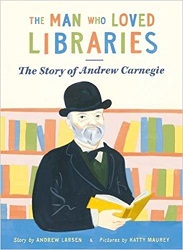
The Story of Andrew Carnegie
Review posted June 2, 2018.
Owlkids Books, 2017. 32 pages.
This is a picture book biography of Andrew Carnegie. It tells the basics of his life, that he was born into poverty in Scotland, but his family emigrated to America. He worked as a child in a cotton mill, then as a messenger boy.
A wealthy businessman opened the doors of his private library to young workers on Sunday afternoons, and that was how Andrew Carnegie got his education. He then was able to become a telegraph operator and worked his way up in the Pennsylvania Railroad Company.
Here’s how the book explains Andrew’s wealth:
Andrew believed railroads were the key to the future. His first investment was with the Woodruff Sleeping Car Company. He went on to buy shares in companies producing oil and iron and steel, as well as those building the rails and bridges that were weaving their way across America. When they made money, he made money.
By the time he was thirty-five, Andrew Carnegie’s investments had made him a rich man. He had more money than he could ever need. So what did he do?
He gave it away.
Andrew Carnegie never forgot the kindness of Colonel Anderson. He never forgot the light and warmth of the colonel’s library or how he loved to borrow the books that filled its shelves. He never forgot the joy he felt in learning.
Andrew Carnegie used his own money to build public libraries so others could have the same opportunity.
He built his first public library in the small Scottish village where he was born. But he didn’t stop there.
It goes on to tell about the many public libraries he built – more than 2,500, all over the world.
A note at the back gives more details. It also mentions that his relationship with his own workers – and their unions – was “complicated.” But the focus is on his amazing philanthropic efforts and the work still being done today by the Carnegie Corporation that he set up.
